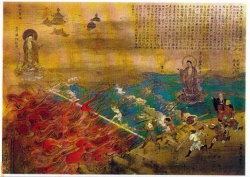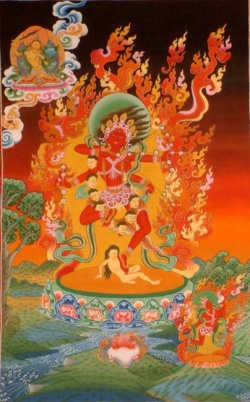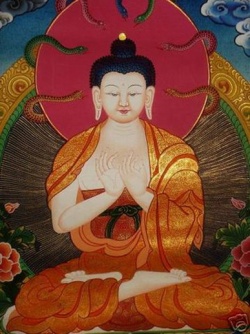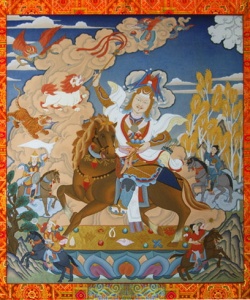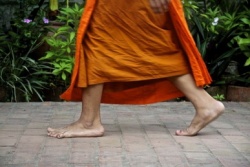Mara in doctrine
As in most religions, the objectification and validity of the embodiment of evil is maintained as a persona in Buddhism, as existent and embodied in other than the empirical self. As against sutta, Buddhism in no way differs from modern connotations of Satan, or in Buddhism’s case Mara, wherein it miserably diverges from the doctrinal denotation that in fact one’s self, Gotama or any other persona, is none other than Mara (or Satan). It is true that Mara, in doctrine, is a persona (empirical self), however not as differentiated from the persona that is either Gotama or any person “who can be called by name”, against which the Buddha is a “not-person” [SN, common proclaimation]; this is yet another point of fine metaphysics which has been bastardized by the common and profane religionists over time, just as Satan is not a being in the Bible; but Satan, who remains an angel even in hell, can be called a persona, or, indeed, persons, since his name is "Legion: for we are many", that being the ‘many’ (= “Mara’s army”) which comprise the composite and existential persona which is ones self (Bob, Sue, Gotama, etc.). Of the two in us, one the "spark" of intellectivity (nous, citta, noesis) or Spirit, and the other, feeling or mentality, subject to persuasion, it is obvious that the latter is the "tempter,". That the soul itself, our "I" or "self" itself, should be the Devil whom we call the "enemy," "adversary," "tempter," "dragon," -- never by a personal name (Even the Hebrew Satan, "opponent," is not a personal name). 'Be simply and wholly bereft of self.'" For "there is nothing else in hell, but self-will (attabhava, ahamsome); and if there were no self-will, there would be no devil and no hell." In the Shaker hymn we have: But now from my forehead I'll quickly erase the stamp of the Devil's great "I." Just so is the case in Buddhism that Mara is not a being, nor an autonomous objective reality in sutta, but malady, plague, death (=Mara, “king of death”).
Our whole metaphysical tradition, Christian, Vedantic, Buddhist, Advaitic, and other, all maintain that "there are two in us," [[[Wikipedia:Plato|Plato]], Republic 439DE, 604B; Philo, Deterius 82; St. Thomas Aquinas, Sum. Theol. II-II.26.4; St. Paul, II Cor. 4:16] this man and the Man in this man; and that this is so, is still a part and parcel of our spoken language in which, for example, the expression "self-control" implies that there is one that controls and another subject to control, or “at war with (rather implied ‘against’) myself”. Of these two "selves," outer and inner man, psychophysical "personality" and very Person (spirit, nous, citta, atman), the human composite of body (kaya, rupa), and soul (colloquially old English personage), and spirit (atman, nous, citta), the former is built up. Of these two, on the one hand body-and-soul (or consciousness, vinnana, jivatman, namorupa), and on the other, spirit, one is mutable and mortal, the other constant and immortal; one "becomes," (bhava) the other "is," (thita) and the existence of the one that is not, but becomes, is precisely a "personification" or "postulation," since we cannot say of anything that never remains the same from moment to moment that "it is” in any true sense. However necessary it may be to say "I" and "mine" for the practical purposes of everyday life, our ego in fact is nothing but a name for what is really only a sequence of observed behaviors. "How can that which is never in the same state 'be' anything?" [[[Wikipedia:Plato|Plato]], Cratylus, 439B; Theatetus, 152D; Symposium, 207D, etc.] "'Ego' has no real meaning, because it is perceived only for an instant.” This unfortunately is a point of supreme ignorance amongst modern ‘buddhists’ however who confuse and conceive of atman as = ego, of which no scripture, Buddhist or Vedanta ever makes the error thereof, for the composite and temporal persona (as = ego, or myself, literally person so-and-so) is “na me so atta” (not my Self, my Soul), which is arguably the most common refrain found in Buddhist sutta.
Buddhists, irrationally, like Christians, comfort themselves that their idols, Gotama and Jesus were “free of desires, imperfections, sensuous proclivities”, by rationalizing that Jesus was tempted in the desert by a genuine separate persona, Satan (i.e. evil personified), or that Gotama, in the many instances in sutta (such as the collection found in the Marasamyutta of SN book 1), was tempted by a similar persona, Mara, who commanded Gotama to “forego spiritual life and to seek after pleasures of the body, long life, and or enjoin himself in the endless streams of desires present to the living” (SN1). However by doctrine and logical necessity, the “great evil, king of death”, Mara was none other than the very personage Gotama himself [SN 3.195] “Mara’s-dharma, Mara’s-dharma venerable Lord, in what manner may you describe Mara’s-dharma? The five aggregates are what is meant by Mara’s-dharma.” Also: [SN 3.195] At one time in Savatthi, the venerable Radha seated himself and asked of the Blessed Lord "Mara, Mara I hear said venerable. What pray tell does Mara mean?” Just this, form, Radha is Mara, sensations are Mara, perceptions are Mara, assemblages are Mara, consciousness is Mara. Seeing thusly…this is the end of birth, the Brahma-life has been fulfilled, what must be done has been done." The Person who overcomes Mara, in the case of Buddhism, the Buddha, the Tathagata, is a spiritual sage of “two minds”, that being the self of flesh and blood, and the psycho-physical personage (namorupa) Gotama, and that nobler, better other, so deemed “conqueror, master, light (dipa), Seer!”. That Self which is “always at war with that other self which is foul, of the world, and subject to corruption and decay”, as parroted in: “The Self (atman) is at war with self (anatman, not-self)” [B.G. VI.VI]. The only difference between the liberated sage and the ignorant profane worldling is that the sage has overcome and subjugated the worldly self (bhavanirodha [self-subjugation, = overcoming becoming] nibbanam) by mite of the Self in wisdom. The spiritual and metaphysical adept is one who must be the “dead man walking” who has followed the commandment: “die before ye die!”, and is one who has died to that (mere) self and lives in the Spirit, or as is meant, the Self. This is the discernment between the Great Self (mahatta) and little self (alpatman); or the fair Self (kalyanatta) from the foul self (papatta) as mentioned in Buddhist sutta (Anguttara N.). The “dead man walking” as title of the sage, the wisdom-holder who, though liberated and residing in the unseen Self, yet still ‘walks around amongst the living who are as dead (of spirit)’ is a spiritual appellation of formerly great meaning now misunderstood. To the profane worldling this master-sage is a zombie such that he does not entertain worldly delights, but to that extremely rare sage, all others are the spiritually subjugated, the ‘walking dead (of spirit)’, and depraved who are the genuine zombies of samsara as seen by Him who has “left forever the burden of becoming” (bhava [becoming], as meant = samsarati, i.e. samsara).
It is extremely common fare in ancient religious doctrine to find the sage, the master speaking by means of his Self to his mere personage, or self as an objective entity and temptor, rather than what is truly happening, that being the physical self tempting (in vain, obviously) that nobler Person, Gotama or otherwise; an excellent book on this very topic in ancient thought, is: “The Origin of Consciousness in the Breakdown of the Bicameral Mind” by Julian Jaynes. The bicameral mind of Person and persona are “at war” yet recorded and read (by religious zealots and fools) as though the master sage is at odds with an autonomous entity who personifies (again, self!) evil. Logically so, fully illumined or not, the body is unquestionably the major point of stupefaction for the spirit; however this is a religious heresy as conceived either by Buddhist or Christian, that their idols and masters are subject to bodily desires and its subsequent depravities; but this is nonetheless indeed the case in doctrine. There is in fact no objective autonomous entity which is tempter, evil personified as separate from Gotama the persona. Several of Gotama’s disciples who gained full liberation (or wisdom which fully separated Self from mere self) were said to have “taken the knife blamelessly” in so committing suicide and eliminating final removal of the empirical self which leads to continued stupefaction and potential fall from the grace of liberation. [SN 3.189]
The Mara Sutta is extremely important in that it is outright stated by Gotama that “Mara is not only the five aggregates, the killer, but also the one who is killed”; meaning obviously that all empirical personas are therefore Mara, just as it is said over and over, that all psycho-physicality = Mara, so too therefore is the phenomenal and objective self, or persona also = Mara. Any and all persons, Bob, Sue, Larry, and Gotama himself are indeed Mara. Obviously, logically so, the Buddha was not tempted by the desires and proclivities of his yet still remaining self of flesh and its own will (=vinnana, or empirical consciousness; as MUST be differentiated from ontological mind, or citta). The body is a foul and pestilent plague which no amount of wisdom can rectify; that the Buddha’s body (i.e. Gotama) was riddled with aches, pains, and flatulence in sutta cannot be debated. Like a drunken man whose sensibilities are askew to the extreme, so too this body is a pestilent “burden” (SN4) which must be carried up to death’s gates itself; the mighty sage, be it the Tathagata or otherwise has no recourse for, as has been said, “polishing the turd” this body of which he in ignorance formerly saw his Self as, but which was “not my Self”. In the end, Gotama was thrown upon the funeral fire, wrapped in linen, soaked in oil, and set ablaze like the worthless pile of trash it so genuinely was; this is an immemorial thing of “all which is born and subject to decay”.
Though wisdom may be full and “ripe” as is stated in sutta (in the case of Gotama), so long as spirit is coincident with the foul body whose fruits are lusts, depravities, desires, etc., there will logically and unquestionably be stupefaction and literal war between the self which is Gotama, and the Self which is the “non person” the Buddha, the Tathagata. That wisdom (as meant cittavimutta, liberation of spirit) has been attained, Buddhahood stated, there is still yet no manner by which physical suffering and its brethren desires and afflictions can or may be removed except thru final separation at death of the body. There is neither mention of an end to physical suffering in sutta nor evidence for same in either Gotama’s countless pains in the course of his life, or his bodily suffering and “tremendous pains” (mahaparinibbana sutta) shortly before his physical death. [SN 4.38] “Mara, Mara venerable Lord, in what manner may you describe Mara? When there is the eye, when there are forms, there then is eye-consciousness and phenomena to be cognized, there exists Mara and the what (is deemed) Mara.”
It is no coincidence that earliest iconography of the Buddha would be either an empty seat as worshiped by those gathered round it, a pillar of flame, a swastika (= Brahman), or a hovering wheel; and not was the Buddha represented as Mara, nor was Gotama the personage who was “that evil, that not-Spirit (anatman)”. For the Buddha is spirit (citta, nous), and never (as done so by earliest Buddhism) confused with the empirical Mara, or Gotama who was composed of the corporeal “Mara-aggregates”; “The purification of one’s own mind/will (citta); this is the Doctrine of the Buddha” [DN 2.49], “How is it that one is called a ‘Buddha’?...gnosis that the mind/will (citta) is purified (visuddham)…such is how one is deemed a ‘Buddha’.” [MN 2.144]. Rather fittingly, all present day “statues of Buddha” are in fact statues of Mara (= of Gotama!), those ignorant and profane demons who would presume we find them as Buddhists are in fact those who bow down and pay homage to an eikon Gotama, to Mara, to the empirical persona and self which is “suffering, an ill, as a plague, a boil, a sting, a pain, an affliction, as foreign, as otherness, as empty (suññato), as Selfless (anattato)” [AN 4.422]. That all current “statues of the Buddha” are in fact gold-covered or brass homage’s to Mara, or Gotama, cannot be denied and is most certainly fitting for an perversely upside-down corrupt materialistic pseudo-religion far diverged from its original, which praises Mara-Gotama over that of the Buddha who is spirit and his wisdom-attainment which culminated in the subjugation of the spirit over that of persona (= anatta, Mara, Gotama), or, as depicted in earliest iconography, the Buddha is undepictable, just as in sutta he is deemed a “non-person”; [SN 1.132] In contradiction to Mara, it is declared by Uppalavanna that she is “cittasmim vasibhutamhi”, ‘Lord and master of the citta’, and thereof conquered Mara’s and all his attributes (which comprise person-hood, or ahamsome). The next time one sees demon-‘buddhists’ bowing down before a mere mimesis, an eikon of empirical personage, i.e. a brass statue of Gotama, that same person should with outstretched wisdom recognize that these people are giving praise and worship to all which Gotama in his own words deemed foul, detestable, and evil, which he gave ample illumination against.
The spirit which is = Buddha is not confused in sutta which the Mara-aggregates (in this case of course, meaning Gotama) which is so keenly differentiated in sutta: [MN 1.436, AN 4.422] “Whatever form, feelings, perceptions, experiences, or consciousness there is (the five aggregates), these he sees to be without permanence, as suffering, as ill, as a plague, a boil, a sting, a pain, an affliction, as foreign, as otherness, as empty (suññato), as Selfless (anattato). So he turns his mind (citta, Non-aggregate) away from these; therein he gathers his mind (citta, non-aggregate) within the realm of Immortality (amataya dhatuya). This is tranquility; this is that which is most excellent!” [SN 3.234] “Followers, the desire and lust for formations is a defilement of the citta, the desire and lust for feelings is a defilement of the citta, the desire and lust for cognition is a defilement of the citta, the desire and lust for experiences is a defilement of the citta, the desire and lust for vinnana is a defilement of the citta. But, followers, when one abandons the defilements of the citta regarding these five stations (aggregates), then ones citta inclines towards renunciation. Ones citta is made pliable and firm in renunciation by direct gnosis.” [MN 1.511] “For a long time I have been cheated, tricked and hoodwinked by my citta. For when grasping, I have been grasping onto form, for when grasping, I have been grasping onto feelings, , for when grasping, I have been grasping onto perceptions, for when grasping, I have been grasping onto experiences, for when grasping, I have been grasping onto consciousness.”
For the worldling “lost in the sea of desires”, his spirit is subsumed, sublimated like salt thrown into water, and subjugate (= avijja) in the self, for him there is no distinction between Person and persona, there is only this person ‘so and so’, he is not liberated of which it might be said of him [MN 1.160] “He has destroyed outflowings having intuited vision of wisdom. This followers, is called a follower who has blinded Mara the evil one. Having deprived Mara the evil one’s vision to behold him he has crossed over all desire for anything in this world.” The “temptations of Mara” as enjoined by the Buddha in sutta is the stupefaction of coincidence with Gotama the persona upon the Person, the Buddha, or as distinctly mentioned: [SN 1.103] cetoparivitakkamaññay “Mara…considering upon the reflection (of the Buddha’s mind)” wherein the empirical consciousness (vinnana) of Gotama wages battle with the spirit of the Buddha (citta); or the compounded consciousness at war with the uncompounded mind (citta, or spirit) of the Buddha. To which the Buddha is apposite and replies by means of his wisdom: [SN 1.105] nihato tvamasi antaka’ “Thou-ness maker of ends, (thou) art defeated”, often translated as “You are defeated endmaker”, but which however in the Pali refers not to another persona, but the personage itself (in this case Gotama) who is rebuffed by the Buddha; this again being meant the bicameral mental battle between Gotama-Mara and that of the Buddha who is “no longer subjugate to the whims of objective selfhood” which is ‘na me so atta’ (not my Soul, or Self). Just as the main and subtle differentiation between the criminal murderer and the freeman is the freeman has “self-control”, is “Charioteer” (JN); which in contrast the criminal is subjugate to act willy-nilly without second thought (= reflexive ‘self-control’) upon the whims and desires of his very self, and “does not hold the reigns (of his senses)” (SN1). But in so being coincident with Gotama, the psychophysical person who “is Mara”, the Buddha is therein tempted over and over, but rightly so, does not succumb. This is of course the “inner war”, the “inner struggle” between “a self divided against itself”. [MN 1.227] “Followers, I am an expert in this world and the next, am expert in Mara’s realms and what is outside of Mara’s realm, am expert in the realm of death and what is outside of the realm of death.”
What else would the Buddha make proclamation of in so stating ‘na me so atta’ (this/these are not my soul) than his empirical self, composed of the five khandhas (aggregates) which make up the personage we know as Gotama or any other person? It cannot, logically, doctrinally, sensibly, be another than this. To think, as modern ‘buddhists’ so ignorantly do, that Mara is a genuine personage as autonomous and external ‘boogey-man’ to the already external, objective, and empirical self (Gotama), is none other than ignorance heaped upon ignorance over time immemorial as fool taught fool who in turn taught the ever the more so foolish, the incorrect meaning or earliest and original Buddhism. [MN 1.141] "What do you suppose, followers, if people were carrying off into the Jeta grove bunches of sticks, grasses, branches, and leaves and did with them as they wished or burned them up, would it occur to you: These people are carrying us off, are doing as they please with us, and are burning us? No, indeed not Lord. And how so? Because Lord, none of that is our Soul, nor what our Soul subsists upon! Just so followers, what is not who you are, do away with it, when you have made done with that, it will lead to your bliss and welfare for as long as time lasts. What is that you are not? Form, followers, is not who you are, neither are sensations, perceptions, experiences, consciousness (the five aggregates)."
Mara is none other than the mimetic (mimesis) personage as opposite to, against, and coincident to the eidetic Buddha who is spirit. It is absolutely no coincidence that it is remarked of wise sages that they are indeed “tortured souls”, however the meaning or source of this comment is unknown to most, but which logically stems from the fact that the common fool is not one who is “of two minds” or is divided against himself in that he is both willing and complicit in the bestial and desire-based proclivities of objective personhood, or psycho-physical life [Dhm 7] “Whosoever dwells only in what is pleasureful and sweet, with one’s senses unleashed, fat, lazy, lacking moderation, slothful. Herein one is overcome by Mara the evil one, just as a small tree is swept away to destruction by the great storm”, or [Dhm 46] “Know this, the body is merely foam, a phantom. Verily by perfect knowledge, know that the body is merely a collection of phenomena and a mirage of what is genuine. Destroy the sensuous desires, those flower arrows of Mara the tempter and depart forever from the King of death, go unseen”, or as it is said of this fool, “the wicked have no quarrel with the Devil!”. Not is it the case of the Buddha who, so long as life lasts, must be perpetually tempted by his former identity, Gotama who is none other than Mara [SN 1.115] “the eye is Mara’s, so too are formations, eye-contact, consciousness, ear, sounds, nose, smells, tongue, tastes, the body, all objects, thoughts, mental phenomena; all these are Mara’s”, all of this of course belongs to Gotama. The commoner does not seek after liberation or wisdom, but for continued existence (bhava) as embodied in [SN 1.108] the Sassatavada (perpetuosity, or eternal becoming) heresy as endorsed by mara “the life of mortals rolls on and on, like the chariot wheels felly around the hub (atman). This is the same passage in the Br. Upanishad [2.5.15] “all spokes of the wheel are contained in the axle and in the felly of the wheel, all beings and selves (empirical self) are contained in that Self (atman)”. For such an evil one, [SN 1.111] “a net hovers in the heavens, which catches thoughts (desires, lusts); by means of this net I (Mara) will snare you” But for the sage, [SN 1.112] “the five khandhas cannot find him (the final liberation at death) …Mara (the empirical self) and his army”
The title and premise of this article should rightly prove heretical to the tastes and minds of your typical ‘buddhist’ but not so to those who know both the doctrine and metaphysics of Buddhism and Vedanta well, in so knowing the clear distinction made between self and Self, or persona and Person (spirit, atman, Buddha). However the ‘body of Mara’ which was Gotama and was “born in death….and returned to death” (‘ashes to ashes, dust to dust’) was not the Buddha, nor are the brass and gold images of Gotama recreated countless millions of times and found in temples across the globe, and even key chains, to be looked upon as representing the Buddha or his ministry, but rather a Mara-worshiping later-day persona-based cult which bemuses itself as Buddhism but which in fact is anything but. Gotama’s remains (part of them, as they were divided up and buried far and wide, and worshiped by the so-called ‘relic-cult’ sects) reside in a New Delhi museum inside the pottery jar that contained them inside the stupa these thousands of years and unearthed in the early 1900’s. That modern ‘buddhism’ would choose to make iconography of Gotama, that foul Mara-khandha “rancid heap” [Dhm] which died and was thrown upon the funeral fire is a fitting symbol for its Mara-materialism. Gotama ‘the tempter’, who was Mara, was not the Buddha who was spirit; that person Gotama was born, was sick, was composed of the elements, died, burned, and possessed no ability to cross the portal of death of which the Buddha did cross in knowing what was “beyond Mara’s realm”. Earliest depicters before all sects of Buddhism existed, with depth of wisdom knew this fact and appropriately represented Gotama in one way, and the Buddha in another, for one was Mara superceded by the Buddha who was a ‘non-person’ in the Nikayas, or the “lotus flower (spirit) which arose from the muck and mire (body), and waters (of becoming)”. For the fool however that I have rightly, with evidences from doctrine, logic, and intelligent deduction would deny Gotama as anything other than Mara, or evil, it need be said to those many foolish, that this is no more a denial of the Buddha and his gospel, than is Socrates’ “to…soma….ouk estin ho anthropos” (the body is not the Man [Aniochus 365]) is a denial of the Man, or spirit which is the heart (citta) of both the Buddha, liberation, and his taught endgoal and ministry to transcend, via wisdom, the mundane horrors of existence; and fling with that very wisdom gained, the spirit from this “near shore” of death, empirical identity (sakyanuditthi, as = anatta [DN1]), and becoming, to the “far shore”, that so deemed “unborne, unbecome, and immortal (amata)” (Ud 81), which is “paramo piya” (most exquisitely beloved).
